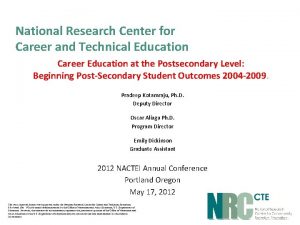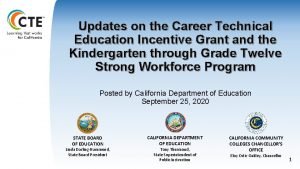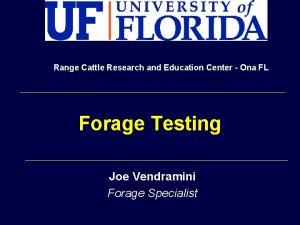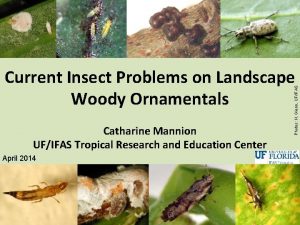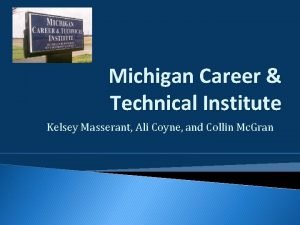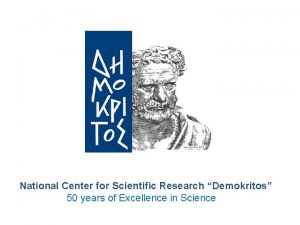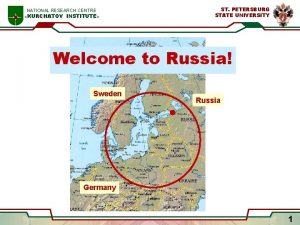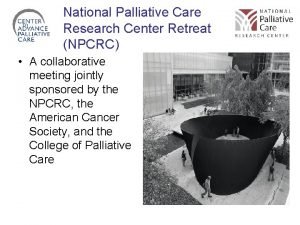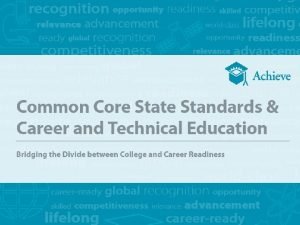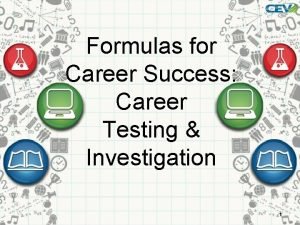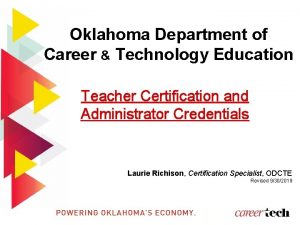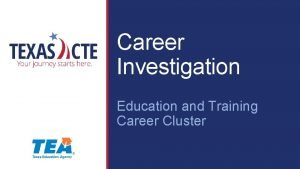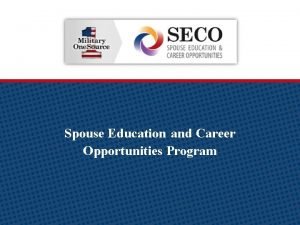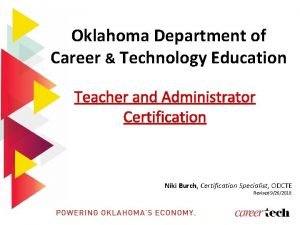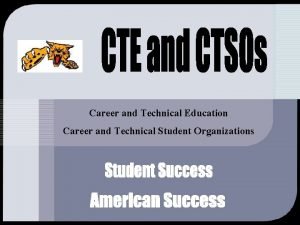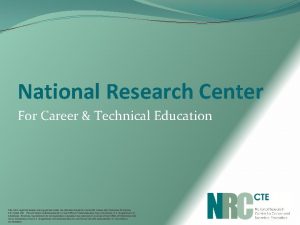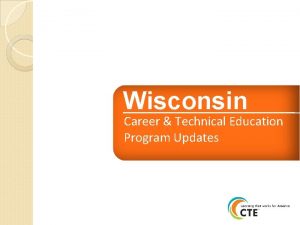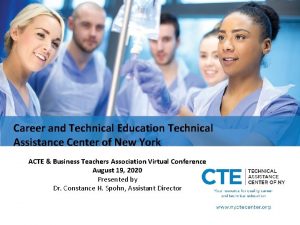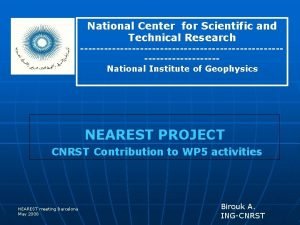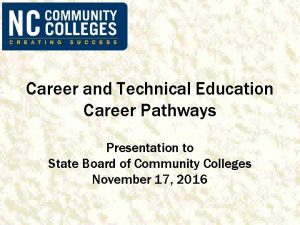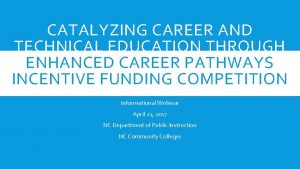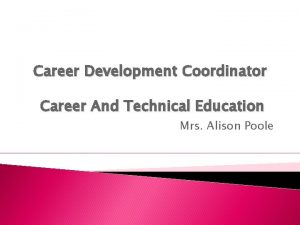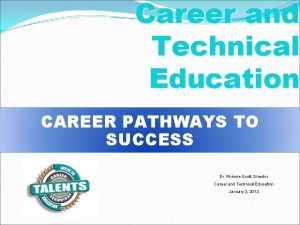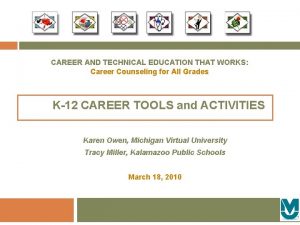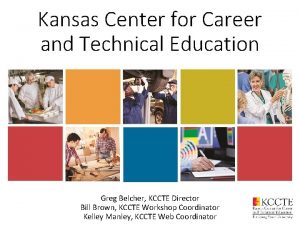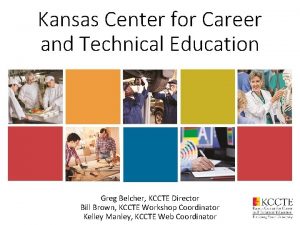National Research Center for Career and Technical Education


















- Slides: 18

National Research Center for Career and Technical Education Simulated Career Preparation Areas and Synthetic Programs of Study: Developing Outcome Measures for the High School and Postsecondary Experiences of CTE Students Oscar A. Aliaga Pradeep Kotamraju May 16 th, 2012 The work reported herein was supported under the National Research Center for Career and Technical Education, PR/Award (No. VO 51 A 070003) as administered by the Office of Vocational and Adult Education, U. S. Department of Education. However, the contents do not necessarily represent the positions or policies of the Office of Vocational and Adult Education or the U. S. Department of Education and you should not assume endorsement by the Federal Government.

What is the story? • Interest in Career Preparation Areas (CPS) • CPS very much like Programs of Study (POS) in Perkins IV • What can we say about POS? 2

Programs of Study—defined • New in Perkins • Elements of other models – Tech Prep – Career Pathways • Perkins: 4 criteria – Secondary to postsecondary – Aligned content, rigorous academics – Dual enrollment opportunities – Lead to credential, or degree (postsecondary) 3

POS in practice • Different understanding of what they are – Across states – Within districts (administrators and teachers) • Different levels of implementation (SC) • Role of guidance counselor 4

Current studies on POS • Studies conducted by the NRCCTE: unique in this area – Longitudinal in nature – Now in its fourth year – Secondary component – Others have looked at the secondarypostsecondary articulation exclusively 5

How do POS look like? • A post-hoc reconstruction approach – “Simulated” or “Synthetic” POS • Use of a national dataset – Educational Longitudinal Study of 2002 – Only complete and current national dataset – Initial information on postsecondary experiences • Students with secondary experience pre. Perkins IV era 6

Method • Used CTE concentrators in specific occupations • Looked into postsecondary • Compared to other groups • Looked into outcomes and other information 7

Typology: Four Basic Categories 8

Simulated POS— 2 -year college N=326, 144 9

Simulated POS— 4 -year college 80, 0 76, 1 70, 0 60, 0 50, 0 40, 0 30, 0 20, 0 10, 0 15, 1 2, 3 2, 7 POS Other Area Fulfiller 3, 8 < 3 Credits Same Area N=1, 019, 469 No CTE Credits Non- CTE College Major 10

Simulated POS— 2 -year college; SES 80 70 65, 6 67, 6 60 50 40 30 18, 5 20 10 0 19, 5 11, 6 4, 1 1, 3 POS 5, 5 3 3, 3 Other Area < 3 Credits No CTE Credits Non- CTE SESFulfiller Q-1 SES Q-2 SES Q-3 SES Q-4 Same Area College Major 11

Simulated POS— 4 -year college; SES 12

Odds of College Enrollment: Propensity Score Matched Sample Female 2 -year college 1. 230 4 -year college 1. 018 Black Hispanic Asian Other 0. 912 1. 465* 1. 206 0. 888 2. 620*** 0. 629* 1. 250 1. 554 SES 0. 874 2. 694*** High School GPA 0. 806* 5. 709*** CTE Concentrator 1. 185 0. 699** 13

POS-2 -year college major (1) HS Concentration(s) Public service Manufacturing Computer science Culinary arts Business Management Agriculture Engineering technologies Manufacturing Computer science Culinary arts Consumer service Communication Construction and Architecture College Major Area Agriculture (n= 302) 100. 0 Construction and Architecture (n= 3, 592) 59. 9 6. 3 12. 2 8. 6 13. 0 Business (n= 5, 669) 25. 7 5. 5 10. 1 11. 7 16. 4 28. 6 1. 9 14

POS-2 -year college major (2) HS Concentration(s) Culinary arts Consumer services Communication Agriculture Marketing Manufacturing Computer science Consumer services Business Management Communication + Consumer services Construction and Architecture Agriculture + Communication College Major Area Computer Science (n= 1, 210) 6. 9 26. 3 16. 2 Health 50. 6 science (n= 9, 368) 10. 0 4. 7 4. 6 30. 6 21. 1 3. 3 4. 9 15. 3 2. 3 15

POS-4 -year college major (1) High School Area(s) of Concentration College Major Area Agriculture + Computer science Agriculture + Consumer service Business management Marketing Business management + Marketing Business finance Communication + Health science Computer Science Health science Agriculture (n= 3, 004) 84. 2 10. 9 4. 9 Business (n= 6, 723) 30. 3 54. 6 3. 3 11. 8 Communication (n= 2, 651) 91. 7 8. 3 Computer Science (n= 4, 416) 100. 0 Health science (n= 5, 034) 100. 0 16

POS-4 -year college major (2) High School Area(s) of Concentration College Major Area Engineering technologies Marketing Manufacturing Business Management Communication Construction and Architecture Agriculture Engineering technologies Marketing Manufacturing Computer science Consumer services Business Management Communication + Manufacturing Construction and Architecture Agriculture Computer Science (n= 3, 079) 1. 6 8. 7 16. 4 24. 2 35. 4 6. 2 7. 4 Health science (n= 8, 846) 4. 1 5. 1 1. 0 1. 2 17. 3 23. 2 9. 9 0. 6 9. 3 28. 3 17

Correspondence Oscar A. Aliaga, Ph. D oscar. aliaga@louisville. edu 18
 National research center for career and technical education
National research center for career and technical education Fcs launchpad
Fcs launchpad Career technical education incentive grant
Career technical education incentive grant Pacret
Pacret Range cattle research and education center
Range cattle research and education center Tropical research and education center
Tropical research and education center Mcti dorms
Mcti dorms National center for scientific research demokritos
National center for scientific research demokritos National research center kurchatov institute
National research center kurchatov institute National research center kurchatov institute
National research center kurchatov institute Npcrc
Npcrc Common career technical core
Common career technical core West career & technical academy amy dockter-rozar
West career & technical academy amy dockter-rozar Formulas for career success: résumés - assessment
Formulas for career success: résumés - assessment Handshake spu
Handshake spu Oklahoma alternative placement program
Oklahoma alternative placement program Education and training career cluster definition
Education and training career cluster definition Spouse education and career opportunities
Spouse education and career opportunities Principal certification oklahoma
Principal certification oklahoma
